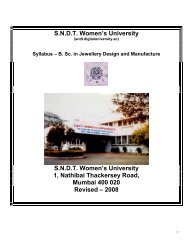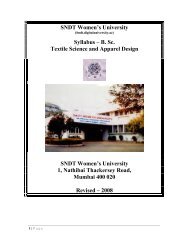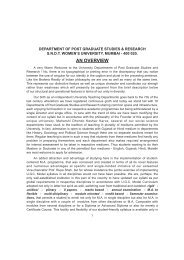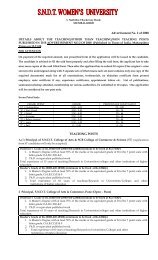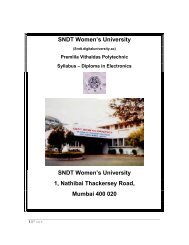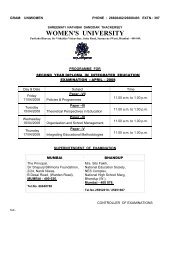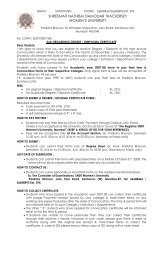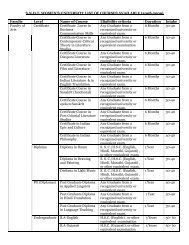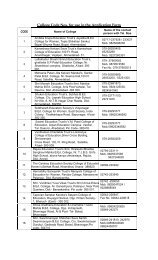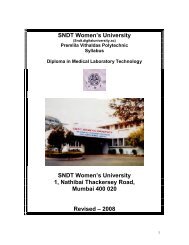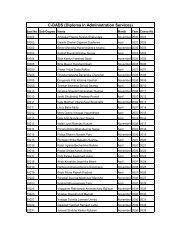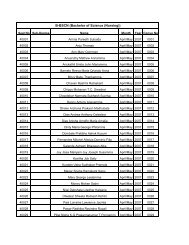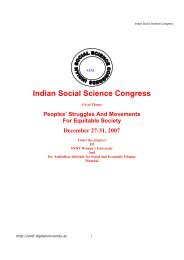XXXI Abstracts Part 1 page 1-189
XXXI Abstracts Part 1 page 1-189
XXXI Abstracts Part 1 page 1-189
You also want an ePaper? Increase the reach of your titles
YUMPU automatically turns print PDFs into web optimized ePapers that Google loves.
third fact implies that if each farmer individually opts for the speculative gain, none would hand over his land; the proposed<br />
industrial project would not see the light of day.<br />
The impasse can be negotiated, if at all, through peoples’ movement. But what step would the movement take? The<br />
answer varies with its basic objective. It may aim at bringing down the incumbent government, or preserving the traditional<br />
way of life at any cost, or facilitating industrialization. In the light of the discourse above, suppose we accept the<br />
achievement of human progress as the supreme desideratum. Now the peasant probably has followed his ancestors’<br />
footstep into the profession of farming, and his descendents would do the same. This is stagnation, not human progress.<br />
The hands of electoral politics are tied to the pleasure of three ruling classes --- social, economic, political. Peoples’<br />
movement has a valid role to intervene in this milieu. It would, however, be a sheer wastage of peoples’ energy if their<br />
movement seeks to make the son of a farmer merely a better plough-pusher, rather than rescuing him from the clutches of a<br />
retrograde tradition.<br />
(b) Purdah: Women are entering all fields of education, training, and work; their dress accordingly is getting<br />
modified in order to accommodate functional convenience. The orthodox school is reluctant to cross the line of tradition. On<br />
the subject of purdah, the tension is palpable.<br />
‘Purdah seems to have grown in India during Mughal times, when it became a mark of status and prestige among<br />
both Hindus and Muslims’, Nehru wrote. 14 Probably this started in the Byzantine court circles and passed through the Arab-<br />
Persian civilization to reach India. He was firmly opposed to the purdah, because in his opinion it results in the seclusion of<br />
women. ‘I have no doubt at all that among the causes of India’s decay in recent centuries, purdah holds an important place.’<br />
‘That it injures women is obvious enough, but the injury to man, to the growing child who has to spend much of its time<br />
among women in purdah, and to society generally, is equally great.’ Mahatma Gandhi was ‘a fierce opponent of purdah’,<br />
which, he thought, had kept women backward and underdeveloped. Sir Sayyid Ahmad Khan was an ardent reformer. He<br />
had established the Aligarh Muslim College in 1881; it was recognized in 1920 as the Aligarh Muslim University. Sir Sayyid<br />
wanted to reconcile modern scientific thought with Islam. This was to be done, of course, not by attacking any basic belief,<br />
but by a rationalistic interpretation of scripture, he said. He denounced purdah (seclusion of women).<br />
India had previously witnessed some segregation of sexes among the aristocracy, as in many other countries and<br />
notably in ancient Greece. Some segregation existed all over western Asia. But nowhere was any strict enforcement. The<br />
origin of the purdah may be traced to the Byzantine court, and from there it traveled to Russia. There was no purdah in<br />
Arabia, or in other parts of western or central Asia. The Afghans, after capturing Delhi, had no strict purdah. Turkish and<br />
Afghan princes and ladies of the court often went riding, hunting, and paying visits. It is an old Islamic tradition, still to be<br />
observed, that women must keep their faces unveiled during the Haj pilgrimage to Makka.<br />
Many women, wearing veil of one kind or another, are finding it difficult to get jobs on account of the dress. They are<br />
particularly common nowadays in Kuwait, the UAE and Saudi Arabia where many women cover their faces in public. In<br />
Dubai, wearing a niqab disqualifies candidates in job interview. The niqab has also provoked sharp controversy in Egypt,<br />
where an increasing number of women are using veil. It is common to see Emirati women in the workplace, most wearing<br />
elegant dress and head covering, but those wearing the niqab, which leaves only the eyes uncovered, are rarely seen in<br />
front offices. ‘Women in niqabs do not sit at the counter. They take administrative jobs,’ said a manager at a Dubai post<br />
office. ‘Clients need to know who they are talking to.’ Face veils have been a hot political issue in many countries over the<br />
rights of wearers to attend school in secular societies or become policewomen, teachers or jobs that involve interacting with<br />
the public. ‘Vast religious upheavals are generally indicative of powerful changes in the productive basis.’ 15<br />
(c) Genetics and Ritual Hierarchy: Theocratic faith has often been mobilized as ‘the opium of the people’ to keep<br />
them subdued. And plenty of scholars have been available to pontificate the virtue of the opium. Recently, an international<br />
(Estonia, India, UK, US) team of geneticists has claimed to have proved that ‘the origins of Indian caste populations’ lie in<br />
their genetics. ‘Indian castes are most likely to be of proto-Asian origin with West Eurasian admixture resulting in rankrelated<br />
and sex-specific differences in the genetic affinities of castes to Asians and Europeans’ (italics added). The team<br />
made the connections with reference to two genetic features, mtDNA and Y-chromosome. 16<br />
The team’s null hypothesis is a composite of three parts, namely, (a) Y-chromosome causes castes, (b) European<br />
Y-chromosome has produced ‘Indian caste populations’, and (c) European Y-chromosome has produced the upper-ness of<br />
upper castes. In our judgment the study has not been able to prove any of these. Its conclusion is, therefore, false.<br />
False, because if Y-chromosome were to produce castes, then castes would have been there all over the earth.<br />
Second, if the European Y-chromosome were to produce upper castes, then all of Europe should have upper castes alone.<br />
How would Europe then do without lower castes? Third, how did the team determine the direction of causation? In terms of<br />
its method (which is dubious), it might as well have concluded that Indian chromosomes ‘caused’ the West Eurasian<br />
‘populations’, rather than the other way around.<br />
Erwin Schrodinger, a Nobel laureate physicist, has reconciled certain anomalies in Darwin’s theory of evolution. An<br />
application of his idea has shown that Y-chromosome does not make castes; rather castes would make Y-chromosome in<br />
the sense that the latter modulates the ‘direction’ of evolution. Human history has data supporting Schrodinger. 17



